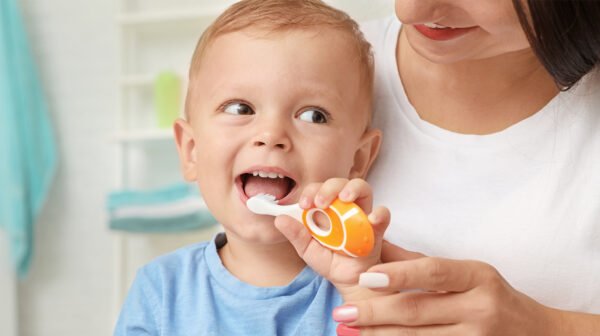Everyone loves a baby’s toothless grin and many parents get sentimental with the appearance of the first tooth. Teething is a major milestone in a baby’s life and it marks the day that he is ready to eat solid food. These tiny pearly whites need to be taken care of or they will cause problems later on. The first step is by making sure the baby’s teeth are clean between meals. Teaching babies to clean their teeth can be quite a challenge for parents. Don’t fret, here are tried and tested ways to make a baby look forward to brushing time.
Buy a colorful toothbrush. Babies and small children respond well to colors. That is obviously the reason why nurseries, toys, and kindergarten classrooms are decorated in bright hues. Bright primary colors like blue and red are particularly attractive to them.
- Use age-appropriate toothpaste. Specially formulated for baby and toddler teeth and gums, these often come in different flavors. Choose one that corresponds to your baby’s food taste.
- Let babies choose their toothbrushes. You may opt to bring the baby to the grocery and let him/her choose his toothbrush. This trains the child to decide on his own welfare early on. Plus you can be sure that he/she will be excited to use it. This is, of course, assuming you follow your locality’s current health protocols. Some areas still don’t allow children inside malls and supermarkets for safety reasons.
- Show the baby how it is done. Babies get cues from adults. Some babies are more observant than others and immediately know how a toothbrush works. Some need to be taught and demonstrated. Parents must be in touch with their babies’ learning patterns. Some may learn better by direct approach while some remember well if it is taught like a game. What works for one baby may not work for another.
- Set a daily routine. Brush his teeth at the same time daily. The regularity will make babies at ease and more comfortable.
- Be generous with praises. When they can hold the toothbrush properly or followed the correct brushing directions or when they remember to brush without being told– acknowledge these achievements. It builds confidence and encourages them to do better.
- Take advantage of toothbrush and toothpaste commercials with kids. Toothpaste and toothbrush ads that target small children are often jolly and have lots of dancing and singing. Sing those jingles to him during brushing time pretending to be the kid on the TV
Bring him to the dentist. Toddlers may be introduced to a dental professional preferably one that specializes in pediatric dentistry. A familiar face also helps like if you have a cousin who is a dentist that the baby sees often in family gatherings. You may be surprised at how they listen when the man in white coat talks to them. This mini field trip will also make them feel at ease for future dental visits.
Tell them teeth-related bedtime stories. Babies love stories. Bedtime stories are a good way of educating children in a fun way. Find books that tell stories about dental hygiene.
Incorporate tooth brushing in pretend plays. When children play pretend, they usually pretend to bake, cook, ride cars or tell stories. You may add personal hygiene routines like brushing and showering.
Good oral hygiene starts early. The most important part of teaching kids how to brush is to make sure they understand why they do it. Knowing the purpose is an effective way to ensure that children continue to follow what you taught them.

